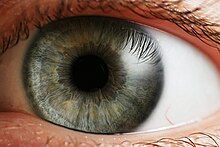
Back Sensoriese senuweestelsel Afrikaans Sistema sensorial AN جهاز إحساس Arabic সংবেদন তন্ত্ৰ Assamese Sistema sensorial AST Сенсор системаһы Bashkir Сэнсорная сістэма Byelorussian Сэнсорная сыстэма BE-X-OLD Сетивна система Bulgarian সংবেদী স্নায়ুতন্ত্র Bengali/Bangla

The sensory system is the way animals find out about their nearby environment and their bodies. To do this they have special devices for collecting data called sense organs. The sense organs act as transducers: they turn energy from the outside or inside of the body into nerve signals. The signals are then very rapidly processed by the brain. The whole arrangement is the sensory system.
It is usual to say the sensory system has five senses:
- Hearing is the sense of sound. Ears hear sounds.
- Sight is the sense of seeing. Eyes see.
- Touch is the sense of feeling. Sense organs feel.
- Taste is the sense of the flavor. Tongues taste.
- Smell is the sense of scent or odor. Noses smell.
There are other senses. For example, we have a sense of equilibrioception which checks our balance, and proprioception which is the sense of the relative position of one's own parts of the body and strength of effort being employed in movement.[1] Fishes have a sense system which no land animal has.[2] It is called the lateral line system. This senses movement and vibration in the water pressure and other functions. Some fish can sense patterns of electrical current in the water.
- ↑ Proske, Uwe; Gandevia, Simon C. (2018-06-18). "Kinesthetic Senses". Comprehensive Physiology. 8 (3). Hoboken, NJ, USA: John Wiley & Sons, Inc.: 1157–1183. doi:10.1002/cphy.c170036. ISBN 9780470650714. PMID 29978899. S2CID 49704241.
- ↑ Most amphibian larvae have a similar system.